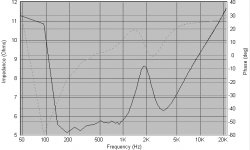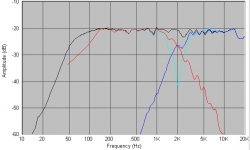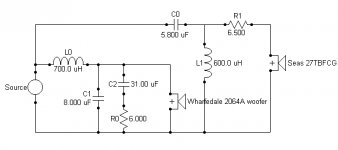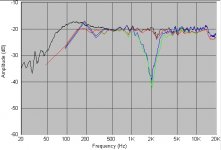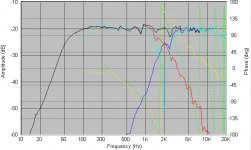As an exercise to test my measurement setup and knowledge of SpeakerWorkshop, I've designed a new crossover for a pair of old Wharfedale 505.2 speakers.
Details are on my web page here
I welcome any feedback, questions or criticism (of the speaker crossover redesign - not the crappy website that is )
)
Thanks,
David.
Details are on my web page here
I welcome any feedback, questions or criticism (of the speaker crossover redesign - not the crappy website that is
Thanks,
David.
Hi
I would be interested to hear how the rdesigned speaker sounds.
One comment is that the 8" base mid unit seems to have an extended upper range. One possibility is that this caused the lack of clarity in the mid range by being too slow as an 8" unit to respond. If you are happy that the 8" is ok then you could improve the mid range detail by direct connecting the 8" base / mid unit ( ie no filter ) and just include a high pass filter on the treble unit. From the look of the curves a one pole or two pole filter might be sufficient for that purpose.
Just a thought.
Don
I would be interested to hear how the rdesigned speaker sounds.
One comment is that the 8" base mid unit seems to have an extended upper range. One possibility is that this caused the lack of clarity in the mid range by being too slow as an 8" unit to respond. If you are happy that the 8" is ok then you could improve the mid range detail by direct connecting the 8" base / mid unit ( ie no filter ) and just include a high pass filter on the treble unit. From the look of the curves a one pole or two pole filter might be sufficient for that purpose.
Just a thought.
Don
I am all for a simpler crossover.
The problem I have with the 8" mid/woofer is it really starts to droop beyond 2KHz and the off-axis response really suffers.
As such, I believe I have to crossover earlier. The 27TBFCG can handle a lower crossover point as long as the acoustic HP is steep enough.
I originally only had an inductor low pass on the woofer resulting in a 2nd order LP slope, but couldn't get good phase integration. I tried crossing over the 27TBFCG higher, but found the off-axis problems and drooping response which led me away from that design.
Going 2nd order on the woofer and adding the 8uF cap helped phase alignment a lot.
At only (?) USD$51, I might just order the parts and try them out. If good, I'll buy a second pair of tweeters.
Cheers,
David.
The problem I have with the 8" mid/woofer is it really starts to droop beyond 2KHz and the off-axis response really suffers.
As such, I believe I have to crossover earlier. The 27TBFCG can handle a lower crossover point as long as the acoustic HP is steep enough.
I originally only had an inductor low pass on the woofer resulting in a 2nd order LP slope, but couldn't get good phase integration. I tried crossing over the 27TBFCG higher, but found the off-axis problems and drooping response which led me away from that design.
Going 2nd order on the woofer and adding the 8uF cap helped phase alignment a lot.
At only (?) USD$51, I might just order the parts and try them out. If good, I'll buy a second pair of tweeters.
Cheers,
David.
Another issue I have with running the 8" driver higher would be increased distortion due to cone flexing. It is a soft polypropylene cone and at higher frequencies I doubt it is acting like a rigid piston. Cutting it off as low as possible would reduce distortion.
Thanks for the advice though.
One thing I might try is remove the impedance compensation on the woofer now it is a 2nd order electrical filter.... may not be required (although will likely result in other component values to be changed). Without the zobel - high frequency impedance might also increase (a good thing).
Cheers,
David.
Thanks for the advice though.
One thing I might try is remove the impedance compensation on the woofer now it is a 2nd order electrical filter.... may not be required (although will likely result in other component values to be changed). Without the zobel - high frequency impedance might also increase (a good thing).
Cheers,
David.
Hi
With the additional information you have given I agree it would not help to run the 8" at higher frequencies. A polypropylene cone does not normally work well in the higher ranges and sounds wooly. You are probably better to cross over lower. If the speaker still sounds wooly I would then add a 5" midrange and use the 8" simply as a base speaker.
Don
With the additional information you have given I agree it would not help to run the 8" at higher frequencies. A polypropylene cone does not normally work well in the higher ranges and sounds wooly. You are probably better to cross over lower. If the speaker still sounds wooly I would then add a 5" midrange and use the 8" simply as a base speaker.
Don
Dave Bullet said:
One thing I might try is remove the impedance compensation on the woofer now it is a 2nd order electrical filter.... may not be required (although will likely result in other component values to be changed). Without the zobel - high frequency impedance might also increase (a good thing).
David.
Hi,
The zobel should not be needed for 2nd oder electrical.
I do not understand the tweeter l-pad values, why aren't they higher ?
This is the root cause of the unnecessarily low high frequency impedance.
Hi sreten,
I was hoping you would reply - you are always a good source of feedback / critique on designs.
Re zobel - agreed. The iterations I went through were:
1. Try first order electrical on woofer to hit 2nd order target acoustic
2. Put zobel in which hit target slope
3. Tried 2nd order electrical on woofer to help shape the 2KHz baffle diffraction anomaly
I forgot to take the zobel off and tune again to see if required. Will do that tonight and post results.
Re tweeter L-Pad. I tried both increasing series / parallel resistance (and one or the other). The net result was too much attenuation of treble relative to woofer efficiency. I either ended up with a lower "shelf" of treble (series resistance increase) or a dip in upper treble (parallel resistance increase) - I might have got that the wrong way around.
In any case if you can offer any advice on how to increase impedance that would be great. I'll model some graphs and post tonight to show you the effects of what I mean.
Thanks,
David.
I was hoping you would reply - you are always a good source of feedback / critique on designs.
Re zobel - agreed. The iterations I went through were:
1. Try first order electrical on woofer to hit 2nd order target acoustic
2. Put zobel in which hit target slope
3. Tried 2nd order electrical on woofer to help shape the 2KHz baffle diffraction anomaly
I forgot to take the zobel off and tune again to see if required. Will do that tonight and post results.
Re tweeter L-Pad. I tried both increasing series / parallel resistance (and one or the other). The net result was too much attenuation of treble relative to woofer efficiency. I either ended up with a lower "shelf" of treble (series resistance increase) or a dip in upper treble (parallel resistance increase) - I might have got that the wrong way around.
In any case if you can offer any advice on how to increase impedance that would be great. I'll model some graphs and post tonight to show you the effects of what I mean.
Thanks,
David.
Hi sreten,
following your advice, I've improved things. still need to play around but here is the latest.... looking better (parallel resistor in tweeter circuit now gone)
I found the zobel on the woofer was still required. A plain 2nd order is not enough (unless I go 3rd order), since a 0.7mH series inductor doesn't give enough cut / shape, and increasing it cuts too much.
Dave.
following your advice, I've improved things. still need to play around but here is the latest.... looking better (parallel resistor in tweeter circuit now gone)
I found the zobel on the woofer was still required. A plain 2nd order is not enough (unless I go 3rd order), since a 0.7mH series inductor doesn't give enough cut / shape, and increasing it cuts too much.
Dave.
Attachments
Dave Bullet said:Hi sreten,
I found the zobel on the woofer was still required. A plain 2nd order is not enough (unless I go 3rd order), since a 0.7mH series inductor doesn't give enough cut / shape, and increasing it cuts too much.
Dave.
Hi,
Are you sure ? looking at it it seems C1's main purpose is to bypass R0.
I think Zobel might be effective in his case. Due to the steep impedance rise over frequency of the woofer, a simple electrical 2nd order may not lead to the target acoustic curve. My hunch is that if it is optimized for a target XO point, then the curve above the XO frequency will not attenuate to the desired slope, and if it is optimized for the desired slope, then the XO point will occur at a much lower frequency than intended.
- Jay
- Jay
Thanks sreten and Jay for your help. 
sreten - I will continue to try and make a 2nd order electrical work by itself. If you are confident it can be done, I am sure it can with some effort. I'm not too concerned if it cannot, since the zobel will only cost about $2.10 in parts per speaker.
Jay - that's what I thought, but I will try different stock crossovers and tweak to see if I can tame the upper end without the xo happening too low.
Either way sreten, you've already improved things for me - thanks again.
David.
sreten - I will continue to try and make a 2nd order electrical work by itself. If you are confident it can be done, I am sure it can with some effort. I'm not too concerned if it cannot, since the zobel will only cost about $2.10 in parts per speaker.
Jay - that's what I thought, but I will try different stock crossovers and tweak to see if I can tame the upper end without the xo happening too low.
Either way sreten, you've already improved things for me - thanks again.
David.
Well - the measured response was pleasing... but onto the listening.
What a disappointment! I'm sure experienced speaker designers can have a laugh (and commiserate) at my experience at my first solo passive crossover design.
Initially - what I thought was great detail has turned out to be listener fatigue. On 70's style popular music (ie. Steely Dan) the balance seems about right. However, on other (brighter) rock / popular music (such as U2, INXS, Prince etc...) the speakers are way too forward.
I cannot pinpoint where in the audio spectrum this is coming from. I am using a 27TBFC/G tweeter which gives nice detail. I especially like how that tweeter can place percussion distinctly and clearly without over emphasizing it.
The speakers measure flat (well within +/- 1.5dB over most of the operating range).
Possible causes I can think of:
1. The Wharfedale woofer is curvilinear and I am wondering whether it is acting like a horn and beaming.
2. is the xo point 27TBFC/G too low?
3. is the woofer LP rolloff not steep enough?
4. Distortion products in the woofer in the upto 3KHz range that I'm not attenuating enough?
5. Maybe I need an upper midrange / lower treble dip to compensate for the bright music I listen to
I feel I might need to measure HD of the woofer to see if it is a contributing factor.
David.
Below is the modeled and measured responses in one graph combined. Colours are as follows. Measured on-axis and reverse null (black and blue). Modeled on-axis and reverse null (red and green)
What a disappointment! I'm sure experienced speaker designers can have a laugh (and commiserate) at my experience at my first solo passive crossover design.
Initially - what I thought was great detail has turned out to be listener fatigue. On 70's style popular music (ie. Steely Dan) the balance seems about right. However, on other (brighter) rock / popular music (such as U2, INXS, Prince etc...) the speakers are way too forward.
I cannot pinpoint where in the audio spectrum this is coming from. I am using a 27TBFC/G tweeter which gives nice detail. I especially like how that tweeter can place percussion distinctly and clearly without over emphasizing it.
The speakers measure flat (well within +/- 1.5dB over most of the operating range).
Possible causes I can think of:
1. The Wharfedale woofer is curvilinear and I am wondering whether it is acting like a horn and beaming.
2. is the xo point 27TBFC/G too low?
3. is the woofer LP rolloff not steep enough?
4. Distortion products in the woofer in the upto 3KHz range that I'm not attenuating enough?
5. Maybe I need an upper midrange / lower treble dip to compensate for the bright music I listen to
I feel I might need to measure HD of the woofer to see if it is a contributing factor.
David.
Below is the modeled and measured responses in one graph combined. Colours are as follows. Measured on-axis and reverse null (black and blue). Modeled on-axis and reverse null (red and green)
Attachments
Hi Salas,
Correct re nearfield / farfield splicing. I will re-measure non-gated at listening position.
I think I might have stuffed up the splicing. I thought my low 0.7mH inductor on the woofer was a little on the light side for BSC.
Then again, the original woofer had a 470uF (yes - that's right) capacitor in-line with the woofer to shape what I thought was a midbass hump. I just thought in box this woofer exhibited minimal baffle step loss based on the nearfield measurements.
Ah well. at least I didn't solder the xo together. It's only temporarily installed in each cabinet. At least I get some spares if a new xo is required with further BSC.
Thanks,
David.
Correct re nearfield / farfield splicing. I will re-measure non-gated at listening position.
I think I might have stuffed up the splicing. I thought my low 0.7mH inductor on the woofer was a little on the light side for BSC.
Then again, the original woofer had a 470uF (yes - that's right) capacitor in-line with the woofer to shape what I thought was a midbass hump. I just thought in box this woofer exhibited minimal baffle step loss based on the nearfield measurements.
Ah well. at least I didn't solder the xo together. It's only temporarily installed in each cabinet. At least I get some spares if a new xo is required with further BSC.
Thanks,
David.
It may well be less than needed BSC the source of forwardness, your reply increases suspicions. So pink far away and we will see.
That 470uF is inline with old KEF practice of making a 12dB bass sloping closed box a 18dB one, gaining power handling against record wrap, helping weaker woofer voice coils of that era, etc, along with the added benefit of protection against amp failure producing DC & fried coils. Works mainly lower than midbass adding some level before cutoff actually.
That 470uF is inline with old KEF practice of making a 12dB bass sloping closed box a 18dB one, gaining power handling against record wrap, helping weaker woofer voice coils of that era, etc, along with the added benefit of protection against amp failure producing DC & fried coils. Works mainly lower than midbass adding some level before cutoff actually.
- Status
- This old topic is closed. If you want to reopen this topic, contact a moderator using the "Report Post" button.
- Home
- Loudspeakers
- Multi-Way
- Wharfedale speaker improvements
